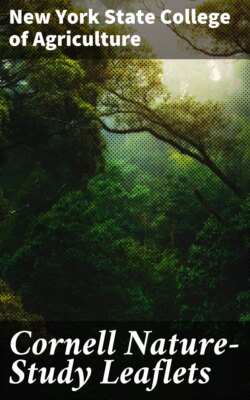Читать книгу Cornell Nature-Study Leaflets - New York State College of Agriculture - Страница 21
На сайте Литреса книга снята с продажи.
Sixth Grade.
ОглавлениеFall work.—Study the spiders. Lessons in Nature-Study, p. 103; Insect Life, pp. 223-232. Cornell Teachers' Quarterly, final number (No. XV, this volume).
In order to study spiders, they need not be handled with bare hands. While all spiders are venomous to the same extent, perhaps, that a mosquito or a bee is venomous, there is only one species in the eastern United States (and that is very rare) the bite of which need be feared by human beings.
The use of spiders in nature-study does not have to do with handling living specimens, but rather with the habits of the different species and the building of the webs. In catching spiders to bring into the schoolroom, use the method indicated by Professor Kellogg in Nature-Study Lessons. Capture the specimen by the use of a pill box: take the box in one hand and the cover in the other, and catch the spider by suddenly closing the box over it.
The pupils should be made to observe the chief differences between spiders and insects; i. e., spiders have two regions of the body instead of three as in insects; eight legs instead of six, simple eyes instead of compound. Compare spiders with daddy-long-legs.
If the teacher chooses to kill a specimen and show the arrangement of the eyes and the spinnerets under the microscope, she may do so. This is not necessary, although I have seen it done successfully in the sixth grade. Diagrams and blackboard drawings may be used instead of the microscope.
Let the pupils observe the uses of silk by the spider:
1. Snare for prey. 2. To enwrap prey when first entangled. 3. Nests for eggs. 4. Lining for habitations. 5. Means of locomotion.
Introduce the grass spider into the schoolroom in glass jars containing grass sod, and let the pupils observe it at work.
Encourage a study of cobwebs. Capture the owner of an orb web, and bring it in a glass jar to the schoolroom. Try to give it its natural environment; i. e., some sort of frame or branch of tree on which it may fasten its web.
The orb web: 1. How is it made? 2. Of how many kinds of silk? 3. The way the spiral thread is arranged as shown by drawings. 4. The position of the spider on the web. 5. The way the spider passes from one side of the web to the other. 6. The way it treats its prey when the victim is once entangled.
The engineering ability shown in making this web is one of the most marvelous things in all the realm of animal life. These observations may well cover two months of this term.
Study the ballooning spiders, the jumping spiders, the running spiders, and the crab spiders. Study as many egg-sacs of spiders as possible.
Another topic for study during the fall term is the Songs of Insects. Insect Life, p. 235. Bring in the katydids, crickets, and meadow grasshoppers, place them in cages containing green sod, and observe them while they are singing. Note that only the males sing. Show the ears of the crickets, katydids, and meadow grasshoppers in the elbows of their front legs. The ear of the grasshopper is on the side of the segment of the abdomen next to the thorax. Ways of the Six-Footed, pp. 3-27.
Study snowy tree cricket. Manual for Study of Insects, p. 118.
If possible, get a cicada as these insects continue to sing through the warm days of September. Show the cover to the drums on the lower side of the common cicada. Cornell Nature-Study Bulletin, No. 1, p. 24 (No. VI, this volume). This can be made a most interesting subject, and pupils should be encouraged to do observation work outside of school.
Begin a general collection for schoolroom.
Spring work.—Continue making a general collection for the schoolroom, and specialize in this direction. When an insect is brought in and added to the collection, if the teacher knows the insect, a lesson should be given on its life and habits. This connecting of the life and habits of the insects with the collection of dead specimens is of greater value from a nature-study point of view than the collection itself.
Summary of methods.—While this year's work must be based on the observations of the pupils in the schoolroom and out-of-doors, yet many interesting lessons may be given by the teacher.
